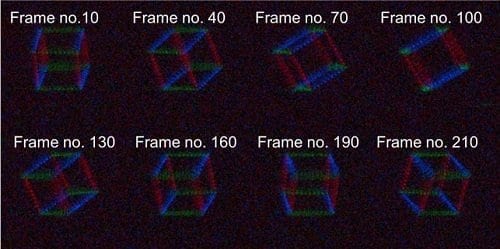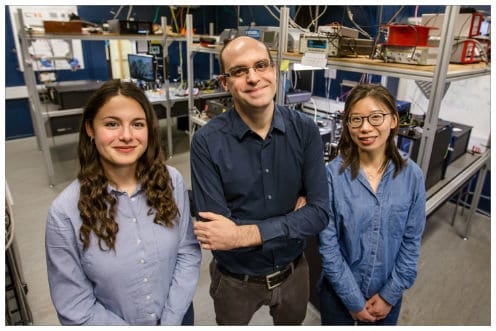
Researchers have designed an ultrathin display that can project dynamic, multi-coloured, 3D holographic images, according to a study published in Nature Communications.
The system’s critical component is a thin film of titanium filled with tiny holes that precisely correspond with each pixel in a liquid crystal display (LCD) panel. This film acts as a ‘photon sieve’ – each pinhole diffracts light emerging from them widely, resulting in a high-definition 3D image observable from a wide angle.
The entire system is very small: they used a 1.8-inch off-the-shelf LCD panel with a resolution of 1024 x 768. The titanium film, attached to the back of the panel, is a mere 300 nanometres thick.
“Our approach suggests that holographic displays could be projected from thin devices, like a cell phone,” says Professor YongKeun Park, a physicist at KAIST who led the research. The team demonstrated their approach by producing a hologram of a moving, tri-coloured cube.

Specifically, the images are made by pointing differently coloured laser beams made of parallel light rays at the small LCD panel. The photon sieve has a hole for each pixel in the LCD panel. The holes are precisely positioned to correspond to the pixel’s active area. The pinholes diffract the light emerging from them, producing 3D images.
Previous studies from Professor Park’s group have used optical diffusors for the same purpose, but the size of the device was bulky and difficult to be operated, and it took a long period of time to calibrate. In the present work, on the other hand, the group tailored their photon sieve to demonstrate a simple, compact and scalable method for 3D holographic display. This technique can be readily applied to existing LCD displays.
Applications for holograms have been limited by cumbersome techniques, high computation requirements, and poor image quality. Improving current techniques could lead to a wide variety of applications, including 3D cinema viewing without the need for glasses, watching holographic videos on television and smart phone screens.
Learn more: A Hole in One for Holographic Display
The Latest on: Holographic display
[google_news title=”” keyword=”holographic display” num_posts=”10″ blurb_length=”0″ show_thumb=”left”]
via Google News
The Latest on: Holographic display
- First in-plane automotive HUD with multiple transparent displayson April 26, 2024 at 5:55 am
Transparent display startup Ceres Holographics has demonstrated what it claims is the first in-plane heads-up display (HUD) with multiple, separate transparent displays in one automotive windshield.
- Swave Photonics develops true holographic display for spatial computingon April 25, 2024 at 1:00 pm
Swave Photonics, a "true holographic display" company, announced the world’s first 3D holographic display technology for XR.
- Swave Photonics debuts Holographic eXtended Reality display with tiny-pixel technologyon April 25, 2024 at 6:00 am
Holographic display startup Swave Photonics today announced the development of what is claimed to be the world’s first 3D holographic display technology for compact extended reality form factors such ...
- Swave Photonics Developing World’s First True Holographic Display Technology To Power Reality-First Spatial Computingon April 25, 2024 at 2:00 am
Emerging category of display technology delivers world’s smallest pixel to steer light, render vivid 3D images LEUVEN, Belgium & SILICON VALLEY, Calif., April 25, 2024--(BUSINESS WIRE)--Swave ...
- Holographic Displays Offer Glimpse Into Immersive Futureon April 24, 2024 at 9:59 pm
Setting the stage for a new era of immersive displays, researchers are one step closer to mixing the real and virtual worlds in an ordinary pair of eyeglasses using high-definition 3D holographic imag ...
- Mark Zuckerberg appeared to take a shot at Apple's Vision Proon April 24, 2024 at 4:09 pm
Meta CEO Mark Zuckerberg said he didn't think augmented-reality headsets would make it mainstream yet, but smart glasses could.
- Illustration of a holographic display with the new optical device (IMAGE)on April 24, 2024 at 3:38 am
Researchers at Princeton and Meta have created a tiny optical device that makes holographic images larger and clearer. Small enough to fit on a pair of eyeglasses, the device could enable a new kind ...
- Holographic displays offer a glimpse into an immersive futureon April 23, 2024 at 9:23 am
Setting the stage for a new era of immersive displays, researchers are one step closer to mixing the real and virtual worlds in an ordinary pair of eyeglasses using high-definition 3D holographic ...
- Holographic projections in automotive heads-up displayson April 17, 2024 at 7:21 am
The first was addressed earlier and relates to its ability to project virtual images with true depth cues and without a loss in resolution.
- IDTechEx Explores the Potential of Holographic Projections in Automotive Heads-Up Displayson April 16, 2024 at 11:32 pm
Automotive heads-up displays (HUDs) are currently being met with great enthusiasm and expectations. The increased usage of technology while driving and with drivers having to deviate their gaze from ...
via Bing News










